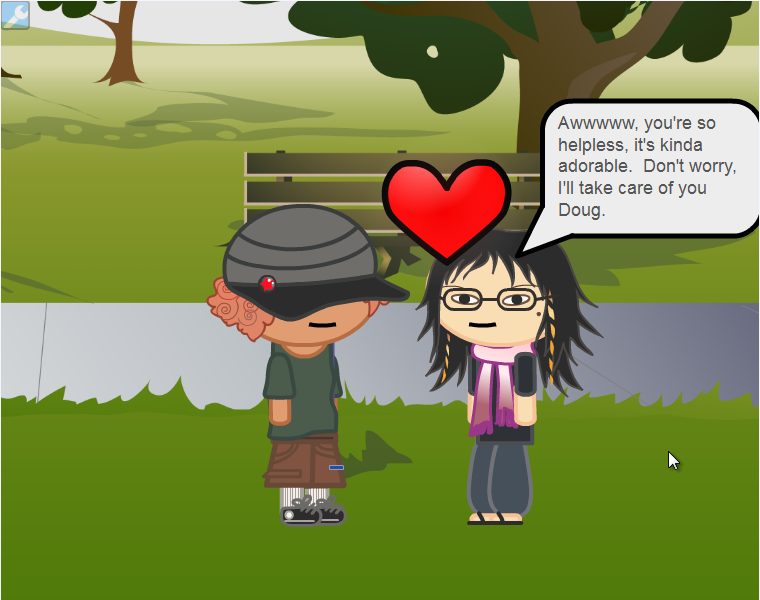Prom Week (Browser / Facebook)

I never went to prom. I know this may sound shocking – a video game fan who grew up to become a critic, who also didn’t do the normal high school traditions?!? Strange but true! Really, the only positive associations I have with prom come from a single episode of Buffy The Vampire Slayer. So how on earth does a game named Prom Week hold any appeal to me? Two words: “social physics.”
That’s how the game’s engine is described. Why is this appealing? Many games don’t try to include social interaction at all, preferring physical, violent interaction. That has its occasional charms, of course, but it’s also a pretty significant limit on the medium of video gaming. Games that do include social interaction tend to do so in a too-straightforward fashion: pick this option to look like a good guy, or this option to look like a bad guy. Any reactions to those choices are specifically programmed. It’s simple: if x, then y.
Yet most every other action the player can take in a game is far more complicated than the simple, direct responsiveness of in-game social interactions. If you get into a fight, there are dozens of things happening at once. How many enemies are there? What kind of weapon are you using? Do you have party members? Are enemies behind you where they might use a bonus? Should you reload now or later? Crouch or jump? Duck towards the nearest cover, or try to move in closer? To call this a “physics” system might be reductive, but it is a complex system, with a variety of different influences pushing you the player into making different choices according to the circumstances.
So, social physics. Just in the name of the term itself, it implies so much. It says “Here is a game system where multiple different factors influence character and player behavior.” This is an accurate summation of Prom Week’s successes, which makes it a magnificent technical achievement. Unfortunately, it’s also an accurate description of Prom Week’s limitations – it rarely goes beyond that.
The second appealing thing about Prom Week is its setting. Not that the prom itself is appealing, but because it acts as a constraint. All video games have borders. Those that are built on physical interaction have physical borders. Social interaction requires further constraints, and high school in the week leading up to prom is marvelously constrained. There are physical borders and social demands which have the same people working towards the same place and time with similar kinds of motivations. There aren’t many of these constraints in storytelling. A murder mystery with a set number of suspects, like Clue, is another one, as is a conference where many people arrive, stay in similar areas, then leave. But prom week is more universal. Chances are good that most players lived through a prom week, or has at least seen television shows on the subject.
The stakes are also lower, which isn’t always a good thing, but it makes sense in this case. If it were a murder mystery, then the player’s goal would be to solve the mystery, not necessarily to understand Prom Week’s system. But since that system is the main draw, that’s where your attention will be.

That system is relatively simple. There are eighteen characters, all fulfilling certain types: snobs, jocks, ravers, goths, etc, although there’s enough personality in the writing to forgive the familiarity. Up to eight characters can be on screen at a time, although the others stay appraised of changes in relationships via text messages. Every one of the characters has multiple different moods, like embarrassed or happy.
They also have three different perceptions of each other: friendship, romance, and cool. When those match up, the characters have a relationship change. This level of dynamism means that relationships can get complicated – friends can have a fallout and hate each other, but still have romantic feelings. These things are further complicated by characters having a history with each other, and being concerned about their other friends and enemies. By incorporating multiple different motivating factors, Prom Week models the dynamism of relationships well.
-

-

-

-

-

-

-

-

-

-

-

-

-

-

-

-

-

-

-

-

-

-

-

-

-

-

-

-

-

-

-

-

-

-

-

-

-

-

-

-








































